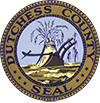The Upper Landing is a foundational location for both the city of Poughkeepsie and Dutchess County. It first served as a hunting and fishing ground for Native Americans for thousands of years, and it became one of the first areas in Dutchess County settled by Europeans. It served as homestead, mill site, commercial dock, Revolutionary War depot, industrial hub, and electrical power generation source for its surrounding area. In its newest phase, the Upper Landing has become a park, open to all who wish to enjoy its beauty and its history.
Timeline
Visit the interactive timeline of the history of the Upper Landing »

A History of the Upper Landing
Chapter 1: Native Americans, the Dutch, and the English »
On May 5, 1683, a Wappinger named Massany signed a deed giving control of the land around the Pooghkepesingh falls to two Dutch settlers, Pieter Lansingh and Jan Smeedes, who planned to build a mill on the small creek running from the falls. Over the next twenty years, Dutchess County and the town of Poughkeepsie slowly grew along the banks of the Hudson.
Chapter 2: The Upper Landing in War, Revolution, and the Republic »
Martin Hoffman, who acquired the Upper Landing in 1755, made a number of improvements and additions to his new property. Perhaps his most important contribution to his property was his construction of a dock in the small cove at the mouth of the Fall Kill. It was this dock, built to service the mill on the property, which gave the Upper Landing its name.
Chapter 3: The Upper Landing at the Dawn of the Industrial Revolution »
The last decade of the 18th century was a time of growth and productivity for both Poughkeepsie and the dock at the mouth of the Fall Kill. As Poughkeepsie grew, the Upper Landing served as a major entry point for building materials. An 1804 flyer portrayed the Upper Landing as an all-encompassing center of business, focusing on the variety of grist, lumber, and plaster mills on the property.
Chapter 4: The Reynolds and Innis Era »
George Oakley, who owned much of the Upper Landing and many of the businesses there in the early 1800s, sold part of his share of the business to George Reynolds and Aaron Innis on October 10, 1816. Reynolds and Innis quickly became the driving force of commerce at Upper Landing.
Chapter 5: The Upper Landing as a Hub of Commerce and Transport »
The mid-1820s saw an expansion of shipping traffic into the Upper Landing. In 1826, the dock became home to the steamboat Franklin, which sailed regularly to New York City. Unlike the sloops that sailed from the landing every other week, the Franklin ran to New York three times a week.
Chapter 6: Rail and Steam at Upper Landing »
Under the capable hand of William Reynolds, son of James Sr., both industry and shipping continued to flourish at the Upper Landing during the 1840s. However, the 1840s also brought a new development to the Poughkeepsie waterfront: the railroad.
Chapter 7: The Long Decline »
While the arrival of the railroad to Poughkeepsie was originally a boon for the Upper Landing, the ever-growing dominance of freight trains eventually crippled shipping businesses and their dependents at the site. The economic death of the Upper Landing took decades, but progressed in a steady downward slide from the 1870s.
Chapter 8: The Legacy and Resurgence of Upper Landing »
Though everything but the Central Hudson power plant had closed at the Upper Landing by the second decade of the 1900s, this important site was not forgotten. Concerned citizens were successful in ensuring that the Hoffman and Reynolds houses, the oldest structures remaining at the site, survived the 20th century to receive renewed attention in the 21st.
Downloads
Historic Structures Report »
The completed Historic Structures report provides in-depth historical and architectural information pertaining to the Hoffman and Reynolds houses.
Summary History of the Upper Landing »
A downloadable PDF of the history pages described above is available. This was written by Michael Diaz, incorporating research done by George Lukacs.
To request a copy of the Upper Landing History by George Lukacs click here »
Original Upper Landing history research by George Lukacs and the primary source material for the history on this website. (100 page document)
